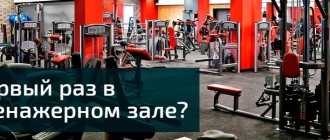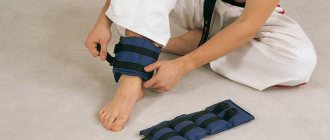Safety precautions are a set of rules that should be studied before starting any activity. Why? Because all these rules were learned through practice, and there were people who ignored these rules and paid for it with their health. And we strongly recommend learning from the mistakes of others, rather than making mistakes yourself! As for the gym, safety precautions play a special role here. A rocking chair is a place where people lift objects so heavy that the weight of these objects can not only injure, but even kill. And there were such cases! You can see this for yourself by searching for videos on YouTube. People dropped barbells on their throats and fell with them, and did not always get away with a slight fright, so take safety precautions seriously!
Of course, there are more and less important rules, although it should be remembered that the consequences of both may be irreversible. You see, the fact that the risk is lower in one case does not reassure you when something bad happens to you. Yes, dropping a barbell on your throat is less likely than injuring your shoulder by performing this or that exercise incorrectly, but this hardly gives peace of mind to a person who feels the full weight of the “world” on his throat. And, nevertheless, the basic safety rules in the gym include: a sound assessment of your capabilities, the correctness of clothing and equipment, warm-up and, first of all, the serviceability of the technical equipment of the gym. Secondary factors include the training partner and appropriateness of behavior. Now let's look at each point in detail!
Content
- 1 How to avoid dropping a load on your foot: safety tips
- 2 Basic safety laws for strength exercises 2.1 Warming up muscles before training
- 2.2 Start with a lighter weight
- 2.3 Correct breathing
- 2.4 Technique 2.4.1 About the benefits of water
- 3.1 Safety Tips for Free Weights
How to avoid dropping a load on your foot: safety tips[edit | edit code]
There is nothing dangerous about weight machines, dumbbells or barbells as such. In fact, what you do with these devices can actually crush your fingers, strain your muscles, or tear your ligaments. If you're careful, use proper technique, and don't grab too much weight for the sake of it, you can live for many years without any injuries. In fact, one of the main reasons for strength training is to reduce the risk of injury in your daily life by strengthening your muscles and bones. Follow the safety tips in this article and you can avoid the injuries and problems that most gym newbies face.
General rules of gym clubs.
- If you don't know how to use the machine, ask a gym worker. There's nothing wrong with that.
- Don't go to training if you have a cold. You should not infect other people. Feeling unwell? Skip class.
- If you need insurance, ask someone to cover you. You should not expect that you can lift any weight without help from others.
- Don't just occupy a bench. If you are relaxing and decide to use your phone, you should not sit on a bench. Perhaps someone wants to work out.
- Don't eat in the gym or locker room. Typically, sports clubs are equipped with cafes where you can calmly have a snack.
Before purchasing a membership, check with the employees about the rules of the gym. They may vary from club to club. The article discusses standard rules, but there are some peculiarities. Depends on the direction and status of the simulator. In gyms, for example, in the premium segment, there are additional requirements for athletes.
Read further:
- Relief from back pain: 5 yoga exercises
- Cramps after exercise: causes, prevention and solution to the problem
Was it useful? Share with your friends:
Basic safety laws for strength exercises[edit | edit code]
Safety precautions in the gym
As we have already noted, strength training is completely safe and allows you to easily live the rest of your days without the slightest damage. However, your muscles may feel sore from time to time—especially if you're new to exercise or take long breaks between workouts. A little muscle pain after exercise is normal; sometimes it does not appear immediately, but even a day or two after the lesson. (For those who prefer their pain to have a name, this period is called “Delayed Onset Muscle Soreness.”
.) At the same time, there are ways to reduce the level of discomfort, allowing you to feel like a completely healthy and productive person after exercise. The recommendations that you will find in the following sections will help you reduce unpleasant consequences to a minimum.
Warming up muscles before training[edit | edit code]
Main article
: Warm-up in bodybuilding Safety precautions in the gym
Every time before you start exercising, you need to warm up your muscles for at least five minutes of simple aerobic exercise (see tips below). This will improve blood flow to the working muscles and increase their temperature, making them more elastic and less prone to injury. Warming up will also lubricate your joints. Active bone movement stimulates the release of synovial fluid, which fills the joints and ensures their smooth functioning. This will look similar to oiling mechanical joints. If you are planning a workout with particularly heavy weights, then warming up before it should take at least ten minutes.
Try using active isolated stretching (AT)
. It involves locking the muscle opposite the one you plan to stretch and then stretching the targeted muscle for two seconds. Before moving on to the next muscle, the procedure must be repeated 8 to 12 times.
Aerobic exercises are also good, such as walking, jogging, exercise on an exercise bike and a stair climber. They are great for warming the muscles below your waist. Meanwhile, to prepare your upper body muscles, you need to add additional arm movements to these activities.
- Use your arms vigorously when walking, jogging, or climbing virtual stairs.
- When exercising on an exercise bike, slightly rotate your shoulders, spread your arms and try to hug yourself.
- Use aerobic machines that work your whole body, like a rowing simulator, cross-country skiing machine, or a stationary bike with special handles.
Start with a lighter weight[edit | edit code]
Main article
: Linear load cycling
If you intend to do more than one set for a particular exercise, you should always start with 8-10 repetitions using a light weight. The warm-up approach is like a dress rehearsal for the actual performance; it's a way to remind your muscles of the milestones they need to reach. Even huge and scary bodybuilders do warm-up sets. Therefore, do not be surprised to see a person with a barbell of only 20 kg on the bench press bench. Before you have time to think, “What a stupid weight,” he’ll load up so many plates that the bar will begin to bend. Then you will understand that his first approach simply served to warm up the muscles.
If you are overconfident and think that you can immediately grab a lot of weight, then we want to immediately warn you about the possibility of injury. By overloading yourself in the first approach, you risk doing the following:
- lose weight control;
- dropping weight on yourself or people around you;
- strain the muscles so much that they tear;
- Be so tired by the end of the set that you can barely move your feet.
One or more of these troubles can lead to a disruption in your training and a long break from exercise altogether, since you will need time to recover. So be smart and start with a lighter weight—one that you can lift many times before you get tired. Then gradually challenge your body with increasingly heavier loads. In addition, a personal trainer will help you choose the appropriate starting weight for your workouts.
Lifting weights too quickly prevents muscles from developing effectively, but opens up wide scope for injury. When you push, lift or swing a load at express speeds, you can't stop mid-repetition. If the discs are dangling on the barbell, you have taken the wrong position, or you simply don’t like something, you won’t be able to correct the situation right away. Therefore, try to allow at least two seconds to lift the load and two, or even four, to lower it. Some experts say you should move even slower. In any case, if you are knocking and rattling like a machine gun, you just need to slow down a little.
Correct breathing[edit | edit code]
Main article:
Proper breathing - bodybuilding workouts
Breathing is often the most underrated and least understood component of strength training. If you've ever competed in a weight lifting competition, you already know that your breathing can make the difference between victory and defeat.
We are, of course, not saying that you must become a professional weightlifter, and we are not encouraging you to delve into breathing techniques like a Tibetan monk. The optimal technique during exercise is to breathe freely and calmly. There is no need to hold your breath.
Lifting weights causes a temporary but dramatic increase in blood pressure. Usually this is not a problem, but when you hold your breath, the pressure rises much more and then drops very sharply. Holding your breath creates increased intrathoracic pressure—the pressure inside the chest. It cuts off blood circulation to the muscles, but can in turn increase blood pressure. When you relax during the exercise, the muscles relax too, the blood begins to circulate again and its pressure drops. Such a sudden fall can lead to dizziness, loss of consciousness and loss of weight. And if you also have heart problems, then you are in especially serious danger. In general, you should never hold your breath.
Execution technique[edit | edit code]
Main article
: Sports exercise technique
In addition to the general safety tips listed here, try to keep in mind the specific tips we give you for each exercise. Even a small mistake in the procedure, such as arching your back too much or arching your wrist in the wrong direction, can cause serious health problems.
You must learn to adapt your body so that you do not use a single unnecessary ligament, muscle or joint when moving. It is very important that you understand that technique is everything when lifting weights. Improper strength training technique often leads to injury.
Determining proper technique and balance is essential before you begin building muscle—especially before attempting to increase weight. When you start training with heavy loads, mistakes in technique will sooner or later lead to muscle or joint damage.
But don't worry or be disappointed. Correction of strength exercise technique is the norm for all athletes. After all, if you start training with mistakes, you will continue to make them until you go through the difficult path to understanding that you are doing something wrong. You will learn bad habits that will be very difficult to break later.
So, try to follow these tips.
- Never jerk or throw any load suddenly.
- When working out at the gym, don't be afraid to ask for help.
- Ask the gym staff to help you if you have difficulties with certain exercises. The staff is usually very helpful and willing to answer any questions you may have.
- Focus on beginner routines for two or three months before moving on to more advanced strength exercises. Be patient and sooner or later you will start using more and more kilograms of weight; however, for now, prioritize procedure and balance.
Before you can begin to increase the size and definition of your muscles, you must sufficiently develop your neuromuscular system. In other words, you need to improve the connection between your brain and body so that every muscle contraction involves as many fibers as possible. Of course, this development of muscle control takes time, but it is quite possible. Great footballers are not born with the ability to score decisive goals in a World Cup final. It takes years of practice to achieve great fitness, experience and skill level. Training takes time, but it's worth it.
About the benefits of water[edit | edit code]
Main article:
Water during and after exercise
We recommend drinking at least two 200 ml glasses of water before starting a strength training routine and two to four glasses during training. Water is essential for your muscles to work effectively. After all, muscles are considered active tissues, and the concentration of water in active tissues must be significant. Normally, your muscles are made up of 72 percent water, and as soon as there is less water, your performance decreases.
Signs and symptoms of dehydration include:
- dry mouth;
- fast fatiguability;
- loss of appetite;
- dizziness;
- headache;
- dry cough;
- dark yellow color of urine.
Cooling[edit | edit code]
Main article:
Post-workout shower
When doing a particularly fast strength workout, follow it up with five minutes of slow aerobic exercise. Aerobic cooling will give your heart rate, blood pressure and breathing a chance to slow down before you hit the shower. If you performed strength exercises relatively slowly, with long breaks between approaches, then a couple of minutes of stretching is enough for you to cool down. In addition, finishing your workout with a simpler approach to a particular apparatus will help you relax.
Rest for muscles[edit | edit code]
Main article:
Rest between exercises and sets
You can easily lift weights every day - just don't do exercises on the same muscle
two days in a row. As a rule, two days is an ideal break between training the same muscles. The fact is that lifting heavy weights destroys muscle cells. Therefore, the muscles need at least a day to recover and rest so that they can “get back into action” stronger than they were before.
If you ignore this rule, strength training will only make you weaker, not stronger. At the very least, your muscles will be too fatigued to train at their most effective levels.
Gym, where to start training for a beginner
You changed into sportswear, took a bottle of water with you, and entered the hall. And we fell into a slight stupor from the number of unfamiliar mechanisms (simulators) and don’t know where to go. What to do?
1. Sign up for introductory training.
This is a free service where the gym trainer, like a tour guide, will show you the equipment and areas of the club. Let's imagine that you came to me for such instruction. After the greeting and introduction, I will ask you about: the goals you are pursuing by coming to the hall, the time frame for achieving them; physical training; health status (contraindications). And based on the data received, I will select a training option and give recommendations.
2. Of course, it’s better to consult a doctor
regarding your health or sign up for Fitness testing (paid service). During fitness testing: detailed information about your health will be collected - you will undergo functional testing to determine your current physical capabilities; take measurements of body volumes and do a body analysis in the Medass program (determine the percentage of fat, water and dry body mass); At the end, you will receive individual recommendations on training and nutrition.
3. Study the layout of the gym:
Cardio zone
– it presents the following exercise machines: treadmill, bicycle, elliptical, stepper, concept (rowing machine). This is an area where you can run or walk during a warm-up/cool-down, give cardio exercise or exercise for fat burning.
Free weights area
These are barbells, dumbbells, weights, handles and other sports equipment. Training with free weights is aimed at increasing muscle strength, developing coordination and endurance. Many girls consider this zone to be masculine and are afraid to go there, but free weights do not always involve “heavy weights” and extreme loads.
Fitness area
– these are various mechanisms (simulators) for working on all muscle groups. Their advantage over free weights is safety. For beginners, I would recommend training in the gym for the first time. Moreover, each one has clear instructions.
Safety precautions in the gym[edit | edit code]
Strength exercises are a completely safe activity, which only implies the possibility of some injuries. Damage to them is not at all obligatory and inevitable. You can easily minimize the risk by following basic common sense rules. They are simple: always treat your equipment with respect, remain vigilant, and focus on only one task at a time. Then you can enjoy a lifetime of trouble-free gym workouts.
Safety Tips for Free Weights[edit | edit code]
We know of one police officer who, for many years, arched his back so much while performing chest presses that he was eventually forced to resign. Therefore, every time you exercise with free weights, keep the recommendations below in mind.
- When removing weights from a rack or supports, use proper technique
. When you pick up a dumbbell, barbell, or large, heavy plate from a stand, always do the following: bend your knees, not your lower back; - come closer to this or that cargo;
- keep your arms slightly bent at the elbows.
- When moving loads around the hall, pay attention to the following points:
hold a heavy load with both hands; - When carrying discs or other weights, keep them close to your body;
- when carrying a barbell, look carefully where you are going, as a sharp 180° turn with a two-meter barbell on your shoulders can lead to serious damage and injury to other people;
- Carrying a dumbbell in each hand, keep your elbows slightly bent.
- Use cuffs
. A cuff is a special clamp that is used to securely secure the discs to the bar. Very often, when performing an exercise with a barbell, the bar tilts slightly in one direction or another. Without a cuff, the discs can slip, landing on someone's fingers or breaking mirrors on the walls. True, inattentive athletes may have problems with cuffs. We know one woman who was knocked out cold when the guy next to her had his cuff fly off the bar and hit her in the head.
- Do not throw the load on the floor.
After you complete an exercise with dumbbells on a bench (like flyes), do the following: lower the dumbbells to your chest; - slowly take a sitting position;
- control your movements.
Some people simply throw weights, which not only irritates the rest of the gym, but can also be unsafe. After all, dumbbells can fall anywhere, roll and cause injury to someone around you. Therefore, remember once and for all that any cargo must always be controlled.
- Carefully return the load to the supports.
When you finish working with dumbbells, barbells or various weights, do not throw them on the racks, leaning forward with straight knees. Do the following: bend your knees; - connect your abdominal muscles;
- Before releasing the weight from your hands, hold it close to your body.
Be careful not to crush your fingers when placing the weights back on the rack. Unfortunately, we are familiar with this. Terribly unpleasant!
Safety Tips for Strength Equipment[edit | edit code]
One of the marketing arguments for strength machines is that they are safer than free weights. And it’s true - when working with them, you don’t have to worry about being crushed by a 45 kg barbell. How do machines create a safe environment for their users? They place your body in the correct position and guide the movements you perform. But even then, you can get injured if you are not careful enough.
To avoid injury to yourself (and others), follow these safety guidelines.
- Customize each car to suit you.
Some machines require one simple adjustment, such as seat height. Others - two or more changes. In particular, with the leg raiser version of the machine, you need to adjust the backrest of the seat as well as the leg rests. Don't worry, you don't have to get a mechanic's license to customize these machines. Typically, you just need to pull the pin out of its socket, raise or lower the seat to the desired height, and then secure it with the pin again. Certain types of machines are very easy to adjust, even without the use of metal pins. With practice, fitting the equipment will become second nature to you.
Don't be lazy to make the necessary adjustments. Using a weight machine that is not designed for your body is like driving a car while sitting in the back seat: uncomfortable and very risky. When you reach to reach for a handle or sit with your knees tucked to your chest, you risk overstretching a muscle or tearing a ligament. Therefore, you should definitely first adjust the seat and rock on it to make sure it is securely fastened. You don't want the seat to suddenly sink all the way to the floor when you lift heavy weights on it.
- Watch your fingers.
From time to time, weights on a weight machine can get stuck in the air. But do not try to correct the situation yourself by pressing on the slabs or lifting them up. Instead, ask staff for help straight away.
We once saw a gym goer try to finish the load himself. A stack of heavy slabs crashed down, literally crushing his fingers as if between a hammer and an anvil. We have seen more than once other people who had strands of their hair pinched, and one guy even managed to get his genitals pinched. We don’t know the details, and we don’t want to know, but we heard this story with our own ears from a trustworthy exercise equipment salesman who witnessed it.
- Buckle up.
If the machine has a safety belt, use it. He is there for a reason! These belts prevent you from wasting unnecessary muscle strength trying to stay in place by moving a lever or tightening a bar. Most commonly, harnesses are found on older machines for seated leg curls, inner and outer thigh curls, triceps curls, and a few other models.
- Don't invent new uses for exercise equipment.
You wouldn't wash the floors of your house with your favorite sweater, right? You also won't use the TV as a step to reach the top of the buffet. So the machine for developing the pectoral muscles does not need to be used to strengthen your legs.
People are constantly inventing new - unsafe - options for using strength training equipment. For example, to make it easier to do chest exercises, some people also start pushing the levers with their legs. We've even seen people ignore their pecs altogether and use this machine to develop their arms or thighs. Meanwhile, by coming up with the wrong thing, you are asking for injury.
HOW TO TALK TO A PERSONAL TRAINER AT YOUR FIRST WORKOUT
So, you've made up your mind. The fitness club card has been paid for and activated. The group jumping stage is over. You go to the gym.
And then you come there and understand... No, it won’t even be like that... Before you pay for the card, you will be given a standard tour of the club: this is the locker room, these are the steps, this is coach Misha, this is the “Cool” simulator.
And during this “local sightseeing cruise” you will look into the gym with your left eye.
There will be a bunch of incomprehensible iron, chrome handles of ten thousand exercise machines, some kind of cables, something will spin somewhere, something will clang, grind and rattle.
If you are an advanced person, then these pieces of iron will be familiar. And if you are in the gym for the first time, then this feast of bodybuilding will seem like quiet horror. What to grab, where to press, what to put pressure on - all these questions will require an immediate answer.
And now the main thing is not to ruin the first personal computer. Moreover, you often get it for free.
It is clear that the happiness of getting straight to a good specialist is a matter of fortune. Therefore, we do not rely on fortune and take this process completely into our own hands.
So... The mighty administrators of the fitness club may not say, not warn, not enlighten that... YOU WILL BE SUPPLIED WITH AN INTRODUCTORY INSTRUCTION IN THE GYM. Moreover, this instruction is usually free.
And this briefing can become either another tour of the simulators or the first full-fledged free training session. The latter is up to you.











